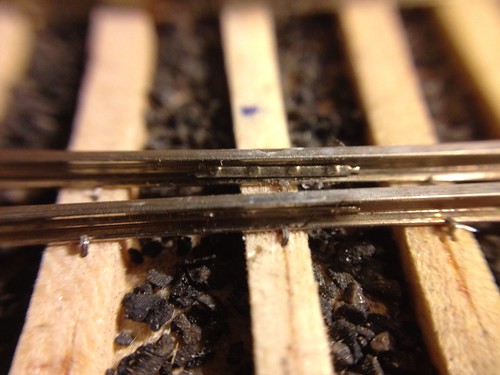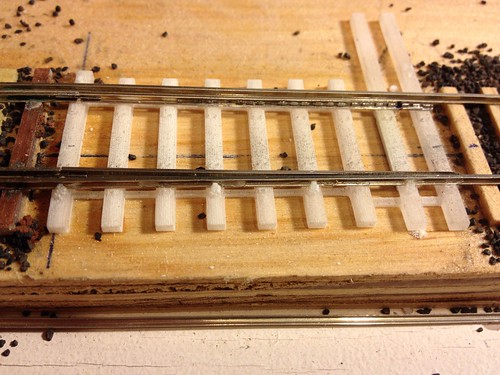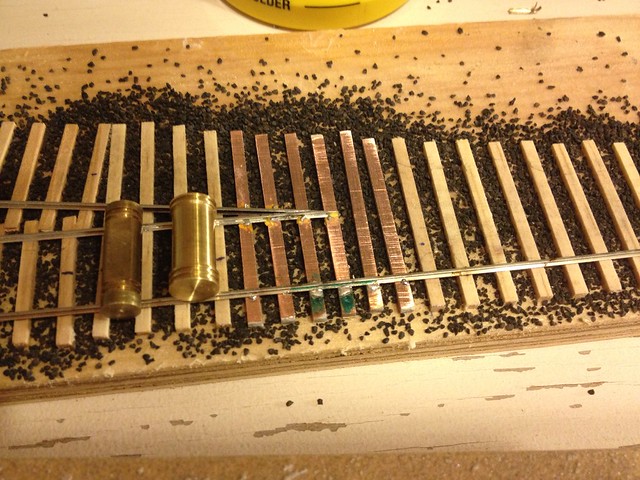Trackwork

How do you clean loco wheels?
Now that I've managed my Labor Day goal of getting my track down (all 20 ft of it), I've discovered the wheels of my Bachman 44 tonner exude black gunk. After a just a couple of weeks on a shelf, it stalls randomly on shiny rails. It's particularly sensitive to track irregularities (nice of it to point those out), and starts up again with just a breath of a push, so it clearly has dead spots on the wheels.
Pembroke II - Track Details
There is a reason why William Cornelius Van Horne paid thousands of navvies to lay the CPR: it is remarkably tedious work! I mean, really, four spikes for every tie! Is it really necessary?
Tonight I shook the frets out of the Proto:87 Stores packaging and tried out some of their joint bars and spikes. The joint bars work fine, if a little subtle. The spikes will drive me crazy!
Pembroke II - Test Switch
It's become fashionable to call the throw bar of a switch by its proper name: switch rod. Now, I'm all for using the correct terminology, but it seems to me that calling the giant chunk of PC board that keeps model switch points the correct distance apart gives these abominations more credit than they deserve. If, on the other hand, we call it a throw bar, and conceal it somehow, we give ourselves an opportunity to create a nice model of the switch rods themselves.

Cornhill & Atherton Turntable Test
To be honest, this is as more a test of me taking a video and uploading it to YouTube..........
However, the turntable works with zero wobble which I am very pleased with, having spent an age building to tight tolerances and doing a lot of adjustment.
Need to work on camera focus but everyone has to start somewhere ![]()
Determining how much ballast you will need?
I have been trying to get an approximate answer on this for quite some time. It seems nobody knows. The usual answers I get are like:
- I just buy more when I run out
- I have a 5 gallon pail and it's all I'll ever need.
- I have a box if it, and don't think it will do my whole layout.
My problem is this:

Code 55, RP25, and HO?
Looking for the voices of experience here, please.
I'm thinking of laying all of the track for my new layout in code 55. It's HO, standard gauge, and code 55 is the closest readily available rail to what I know was used on the railroad, at least in 1917. I'm guessing that it wasn't much different in 1940, and in any case it would definitely give it that lightly built short line feel. If I do it, all the track (including turnouts) would be hand laid using PC ties and/or glue, so no spike heads to worry about.
Pembroke II - Test Turnout Continued
We left off last week with the straight(ish) stock rail in place, congratulating ourselves on a good evening's work, considering we started with bare plywood. This week, we got through most of the rest of the engineering, with the exception of the switch rods. I hope to get those and the remaining details done by the end of the week so I can get back to house construction, and clear up the turnout mess.

Atherton Yard Turntable Complete
Finally got the turntable finished and installed - Just needs the Digitrax auto reverser and approach track linked in and we're good to go..............
Turned out much better than I thought for a cheap eBay 1963 vintage kit (Cliff Line).
There are many bargains about on eBay for the patient - (I recommend casual hunting on a laptop while half watching TV).

Servo as Turnout Motor
>> Posts index
Navigation
Journals/Blogs
Recent Blog posts:



